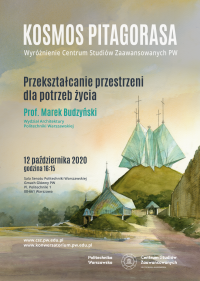6th CAS Distinction for Professor Marek Budzyński, 12.10.2020
Distinction of the Center for Advanced Studies WUT
"Pythagorean Universe"
Laus tibi, non tuleris qui vincula mente animoque
awarded to Professor Marek Budzyński
12.10.2020
On October 12th, 2020 for the sixth time will be awarded the statuette of the Center for Advanced Studies of the Warsaw University of Technology called Pythagorean Universe, whose motto Laus tibi, non tuleris qui vincula mente animoque – „Glory to you for not allowing to put ties on your mind and spirit” perfectly characterizes the unique personality of the laureate, an outstanding architect, Professor Marek Budzyński from the Faculty of Architecture at the Warsaw University of Technology. The ceremony will take place in the Senate Room of the Main Building of the Warsaw University of Technology at 4.15 p.m., during which the laureate will give a lecture entitled "Transforming space for living needs".
Professor Marek Budzyński was born on April 7, 1939 in Poznan. He graduated from the Building Technical School in Warsaw (1956) and then from the Faculty of Architecture at the Warsaw University of Technology (1963). He defended his diploma in Professor Bohdan Pniewski's studio. He received his doctoral degree in 1983 and the title of professor in 2015.
In the period 1965-2016, with intervals, he worked at the Faculty of Architecture at the Warsaw University of Technology.
In 1961-1988 he was a designer and general designer in state design offices.
From 1983 to 1985 he was employed as an assistant at the Institute of Architecture at Lodz University of Technology. In 1971 he worked as a lecturer in Ärhus at the branch of Copenhagen Academy of Fine Arts.
Since 1984 he has been running a studio with Zbigniew Badowski in the cooperative of architects "A".
Since 1993 he was president of Badowski, Budzyński studio, which was joined by Adam Kowalewski in 1997. In 2000 he founded his own studio - Marek Budzyński Architekt sp. z.o.o.
During many years of his work, he cooperated with the following companies, among others: Main Urban Planning Commission, Architecture Council, Programme Council of the former Institute of Spatial Planning and Housing.
He was awarded, among others, the Commander's Cross, the King Stanislaw August Medal, awarded to those who have contributed to the construction of the Capital's majesty, as well as the silver Gloria Artis medal. Winner of the Association of Polish Architects (SARP) Honorary Award.
He is the author or co-author of many realizations, the most important are: Nitrogen plant in Włocławek (1968); Housing complex Ursynów Północny (1972-1980); Housing complex Osiedle Młodych in Nowy Dwór (1978-1983); Church in Ursynów (1980-1985); local zoning plan al.KEN (until 1989); Residential complex at Pasaż Ursynowski in Warsaw (1997); Library of University of Warsaw (1999); Supreme Court Headquarters (1999); Administrative and Technical Headquarters of University of Warsaw Library (2003); Opera and Philharmonic of Podlasie (2012), Bialystok; „Pod Brzozami” housing complex in Ursynów (2011); University of Bialystok Campus (2014); Astronomical Observatory with the Planetarium of the University of Bialystok (2020).
Writing about Professor Marek Budzyński one cannot forget about the projects that were not complited, the more important ones are: Victory Monument in Playa Giron, Cuba (1963); "Linear Concentration”(1968), Museum of the Polish Army in the Warsaw Citadel (1978); residential buildings for copper miners in Lubin (1978); Konstancin-Jeziorna local zoning plan (1994); The Temple of Divine Providence in Warsaw (2000); Embassy of the Republic of Poland in Berlin (2002); Prokom Technology Park in Warsaw (2004); Center for Nature Education „Pod Reglami” (2012); Chalk Hill local zoning plan in Chelm (2016).
Selected publications:
Parcelacja grupowa: propozycja regulacji przestrzennej powstawania nowych fragmentów miast o przeważającej funkcji mieszkaniowej, w warunkach dużej jednoczesności działań, Warszawa 1983; Marek Budzyński Architekt – wydawnictwo SARP 1993;
Utrzymanie życia jako podstawowa wartość przestrzeni miast, w: Wartościowanie współczesnej przestrzeni miejskiej, Warszawa 2010;
Przekształcanie przestrzeni w miasto współżycia Natury i Kultury, w: Odnowa krajobrazu miejskiego. Miasto przyjazne ludziom, wydawnictwo po konferencji ULAR 6, Gliwice 2012;
Rytmy. Powtórzenia. Związki. Uczestniczenie w procesie przekształcania przestrzeni, w: Architektura Muzyki, wydawnictwo po XII Międzynarodowym Triennale Architektury, Kraków 2012;
Articles in journals:
„Architekt”, „Architektura”, „Urbanista”.
